The Few, The Proud, The Machines

It’s the strong boom arm that flexes its metal muscle. It’s the safety of an armored cab that can shield its operator from harm. It’s the combination of human sweat and mechanical oil that is poured into every ounce of effort on the war-torn jobsite. It’s the compact equipment used by the men and women who fight oppression, bravely confront terrorism and protect our freedoms every day.
If you think that you’re hard on your equipment by demanding that it go that extra cycle or dig that extra foot, that’s nothing compared to the demand placed on military machines. Backhoes air-dropping out of the back of a military aircraft and loaders navigating areas with potential improvised explosive devices (IEDs) are all in a day’s work for a military-grade machine. For every machine on your jobsite, there’s likely a military counterpart produced by everyone from Case, Cat and John Deere to JCB, JLG and Navistar.
Though the manufacturing players remain the same in the military market, the differences in military business compared with commercial operations extend beyond the machines. Contracting with the military — be it the United States, United Kingdom or any other nation — is a different beast all together.
“The military bidding process varies greatly in that it requires a team effort throughout the organization,” says Pat Hunt, director of Strategic Accounts for Case Construction Equipment. “Resources from product development, engineering, purchasing, manufacturing, sales, marketing and even human resources — with personnel requirements for training or product support — may be written into the contract. So it may require the efforts of our entire company to meet the government’s needs.”
And the government’s needs are not easy to please. As Chris Saucedo, vice president of Military Products for JCB, can attest to, military contracting isn’t about the lowest bid, but about what the offers present to the government in terms of engineering and being able to produce a machine for an extended period of time with an extended service life. In military circles, it’s referred to as the “best value to the government.”
“Military business is fairly straight forward because the customer [military] tells you exactly what it wants. The challenge is whether you want to do it,” says Saucedo. “Sometimes the requirements are written counter to commercial trends; you have to make some weighty decisions on whether you can feasibly support it.”
The military has been re-equipping its forces over the past five to six years. The compact equipment segment has gone in two directions — from off-the-shelf machines that are purchased commercially and painted a different color to lighter, more mobile equipment that is designed for specialized applications. If a manufacturer takes the plunge into military contracting, it can expect to see contracts for five to 10 years in length at a firm-fixed price. While that puts the onus on the manufacturer to estimate the cost at the beginning of the project, the military is well-funded and isn’t so worried about the acquisition cost.
“When [the military] evaluates your proposal, price is usually the fifth or sixth weighted element,” Saucedo explains. “I’ve seen some proposals where logistics and logistics past performance are rated even higher than technical compliance to their requirements. They’re looking at product life cycles.”
Most commercial compact equipment has a life cycle of about three to five years. In military contracting, manufacturers will have a configuration lock requiring them to build the same skid steer or mini excavator for 10 years, with exactly the same parts. You can’t vary them without military approval. And you have to commit to supporting the product for upward of 25 years.
For example, Case manufactured more than 5,000 M4K forklifts and MW24C articulated wheel loaders for the U.S. military between 1970 and 1990. Six years ago, Case was awarded a contract with the U.S. Army and the Army National Guard to remanufacture many of these wheel loaders and forklifts — some had seen 20 or more years of service.
This equipment sometimes comes to Case in such condition that crews need a crane to take them off the delivery trucks. Case restores this equipment to original specifications, and the Army returns them to service as like-new equipment. This work is done at the Case Remanufacturing Center in Fort McCoy, Wis., and it is the only facility of this kind on an Army installation.
Built to Be All It Can Be
Complications abound when contract requirements are strict and specific. Small business participation, specialized military manuals, parts provisioning and compliance with the Federal Acquisitions Regulations are just a few of the many challenges a manufacturer faces. A typical military request for proposal (RFP) can easily be more than 200 pages, according to Sandra Bridge-Chase, manager of government sales for John Deere Construction and Forestry.
“Governments may start with a request for information [RFI] from the industry to learn what technology is available,” says Elissa Koc, manager of communications, Navistar Defense, a new business established by Navistar in late 2003 to pursue vehicle business with the military, which the company has been supporting since World War I. “Then, a RFP is published so companies can view the requirements for the program. A deadline is often set for companies to submit their proposals for consideration. After a review process a product is chosen.”
So what exactly are the emerging trends in the military’s acquisition strategy? According to Saucedo, there are five main challenges in meeting military requirements: 1) emergent health and safety requirements unique to military operations; 2) human factors engineering; 3) crew protection; 4) energy efficiencies; and 5) green initiatives.
In the commercial world, green buzz words have been thrown around so much in the past few years that they’ve nearly lost their importance. But in military circles, green initiatives tie in closely with energy and machine efficiency, which according to Saucedo, is close to the No. 1 issue looked at when comparing military operations globally.
Green technologies and efficiencies go hand in hand. Technologies such as the use of biofuels and biodegradable hydraulic fuels and lubricants make the machine more efficient and help the operators service them without having to worry about material disposal. A massive amount of research and development goes into military machines. Once you start asking for biodegradable liquids, the question of being able to create a biodegradable filter is the next logical step.
“One of the things that I really enjoy is taking some of the best practices, tests, developments and standards and driving them back into the core business standards,” says Saucedo. “We’ve seen changes in our electrical architecture because of the military applications. We’ve seen changes in our advanced materials groups that are direct military spin-offs. We’ve seen changes in the service side and how we support our customers globally. There are a lot of tangible benefits in being involved in military programs.”
In terms of these technologies and the contracts, if you can reduce the material waste or increase fuel efficiency, that has a cost benefit. That cost benefit is directly related to the acquisition costs and is then added to the logistics cost. And logistics is a huge concern in military contracts.
Traditionally, the military will look at what kind of logistics manufacturers have been able to provide in the past. Then they’ll start with looking at the manufacturer’s global distribution network for parts and distributors. After that, United States and NATO will especially get into more complicated and abstract support infrastructure because they’ll need the same support whether the machines are in a local base camp or landing at the airfield in Kandahar, Afghanistan.
Support extends beyond the parts to the people operating the equipment. Training and personnel support is typical within military contracts. This support is often referred to as integrated logistic services (ILS).
“We perform new equipment training and maintenance training, as well as military specific manuals for each machine that is fielded,” says Hunt. “In fact, we are currently providing skid steer and compact track loader training to Army National Guard and U.S. Army Reserve units.”
No Machine Left Behind
Anywhere in the world where there are military forces, you can bet that military equipment is there. Case is shipping tractor loader backhoes (TLBs), skid steers and compact track loaders to Iraq and Afghanistan. John Deere sends its 624KR four-wheel drive loaders, 850JR crawler dozers and 240DLC excavators to Iraq, Afghanistan, Japan, Korea, Germany, Alaska, Puerto Rico and Norway, to name a few. You’d see Navistar vehicles rolling through military compounds in Iraq, Afghanistan, Canada, Taiwan, Israel and Jordan. In fact, Navistar currently has more than 8,100 7000-MV units and more than 7,000 MaxxPro MRAPs in Iraq and Afghanistan. (Check out the Navistar profile on page 26.)
In addition to its wheel loaders, telescopic handlers, TLBs, skid steers, excavators and a few articulated dump trucks that are spread throughout 60 nations, JCB has deployed a super cool High Mobility Engineer Excavator (HMEE). While it’s a little larger than most compact-size TLBs, the machine hauls at 60 mph with a two-person cab and a weight of 35,000 lbs. Its mobility allows the engineered equipment to maintain convoy speed without needing to be trailered. (More HMEE details on page 28.)
“It’s not what you’d classify as compact equipment, but it is the largest single contract JCB has ever won — commercial or military,” says Saucedo. “Right now, it’s valued in the neighborhood of $220 million to $240 million in procurement. If you look at the life cycle of the program over the next 20 years, that number will be closer to $1 billion.”
Because these machines work in remote locations, delivering them is not as easy as having a local dealer drop it off. In many cases, the machines are air dropped or transported by helicopter. The air mail delivery typically requires additional lift and tie-down provisions in the design stage. While you might argue that lifting an excavator with a crane isn’t that different than lifting one with a helicopter, the major difference is that the helicopter will fly 150 mph with the machine dangling from its cargo straps.
Air drops are the least of the manufacturer’s equipment survivability worries compared to IEDs and other dangers the machine will face when in the field. Take, for example, the Navistar-manufactured International 7000-MV and International MaxxPro. The 7000-MV is a flexible vehicle platform that can be customized into a water tanker, fuel truck or transport vehicle, to name a few incarnations, while the MaxxPro is a mine resistant ambush protected (MRAP) vehicle designed with a V-shaped hull and advanced armor solutions to protect troops from IEDs, road-side bombs and other threats.
Operator safety is inherent in every military machine design. Several manufacturers’ machines, including Caterpillar and JCB, have seen incidents with IEDs; most recent is a story from Caterpillar that is recounted in CE managing editor Keith Gribbins’ Editor’s Message on page 6. Machines have been destroyed by the explosions, but the operators have opened the cab door and walked away safely.
“A lot of pride is taken in the products that we make because they help save lives,” says Koc. “Many of us have friends, family and even colleagues who serve in the military and we only want them to return home safely.”
And that pride and respect for the men and women of the armed forces is shared throughout all of the manufacturers that provide equipment to the military. While it’s good business, the sentiment within manufacturing is that companies support the military because it’s the right thing to do. That support shines through in the multitude of forms manufacturers offer — from safe, efficient machines to long-term support through parts and training. Though the machines help get the jobs done, the true workhorse heroes are the men and women of the armed forces who put their lives on the line to protect those simple freedoms that we are lucky to have.
Jason Morgan is associate editor of Compact Equipment, based in Peninsula, Ohio.
Enlisting Equipment Buy a Military- Grade Machine
If you’re anything like the gear heads in the Compact Equipment office, your head is spinning with the possibility of owning a military-grade piece of equipment. After all, who wouldn’t want a TLB that can fly down the highway at 60 mph? But we’ve found that getting your hands on this equipment is easier dreamed of than done.
With many manufacturers producing military machines with commercial assemblage, it means that there’s nothing in the machine that’s classified or restricted from sale. It’s just commercial equipment that’s been assembled uniquely. However, both John Deere and Case won’t sell you a military-grade machine. John Deere may offer an older military machine minus the cool armor and rifle rack, while Case recommends its 420 skid steer and 420CT compact track loader, which are equal to their M400W and M400T counterparts, respectively.
Similarly, you won’t be able to get your driving-gloved hands on an International MaxxPro MRAP. According to Koc, military vehicles are unique and protected in many ways by international traffic and arms (ITAR) and export compliance regulations. Therefore, a military vehicle may not be available to a contractor even if there was interest.
Of the manufacturers CE surveyed, JCB is the best bet for enlisting a military machine into your equipment outfit. It really just comes down to money — that awesome HMEE backhoe loader runs about $250,000 a machine. If you’re looking for an older machine, JCB has sold legacy machines at a fraction of that cost. So unless you need a machine you can air drop onto your jobsite, chances are it’s a better investment to buy a commercial machine.

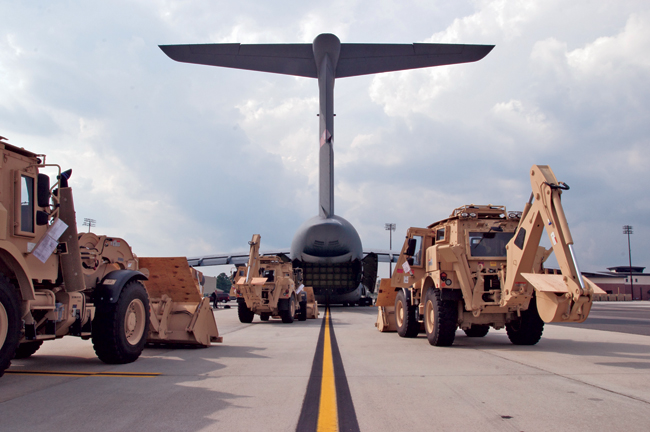
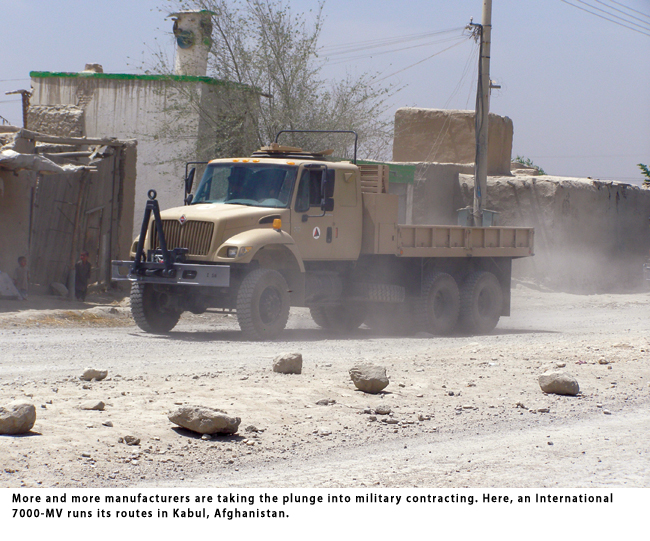
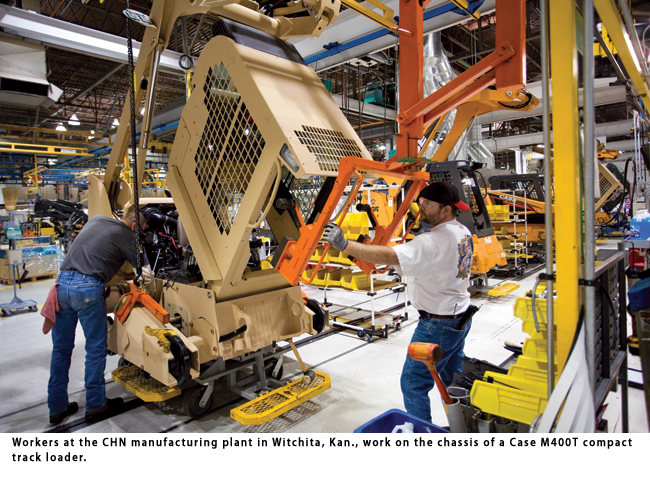
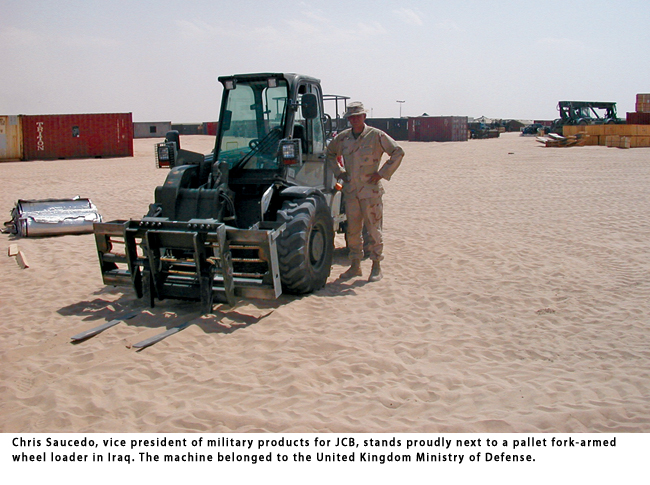
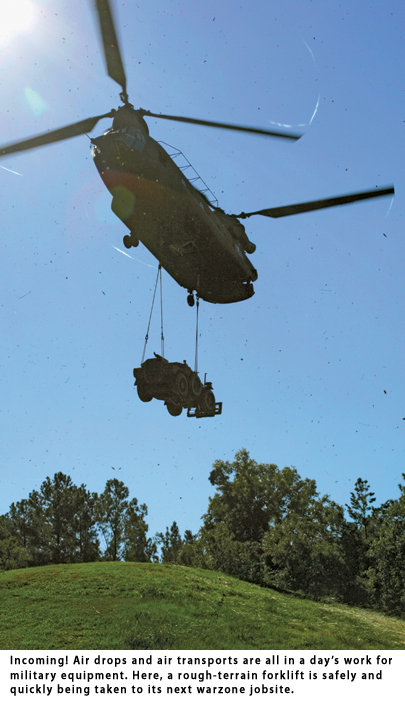

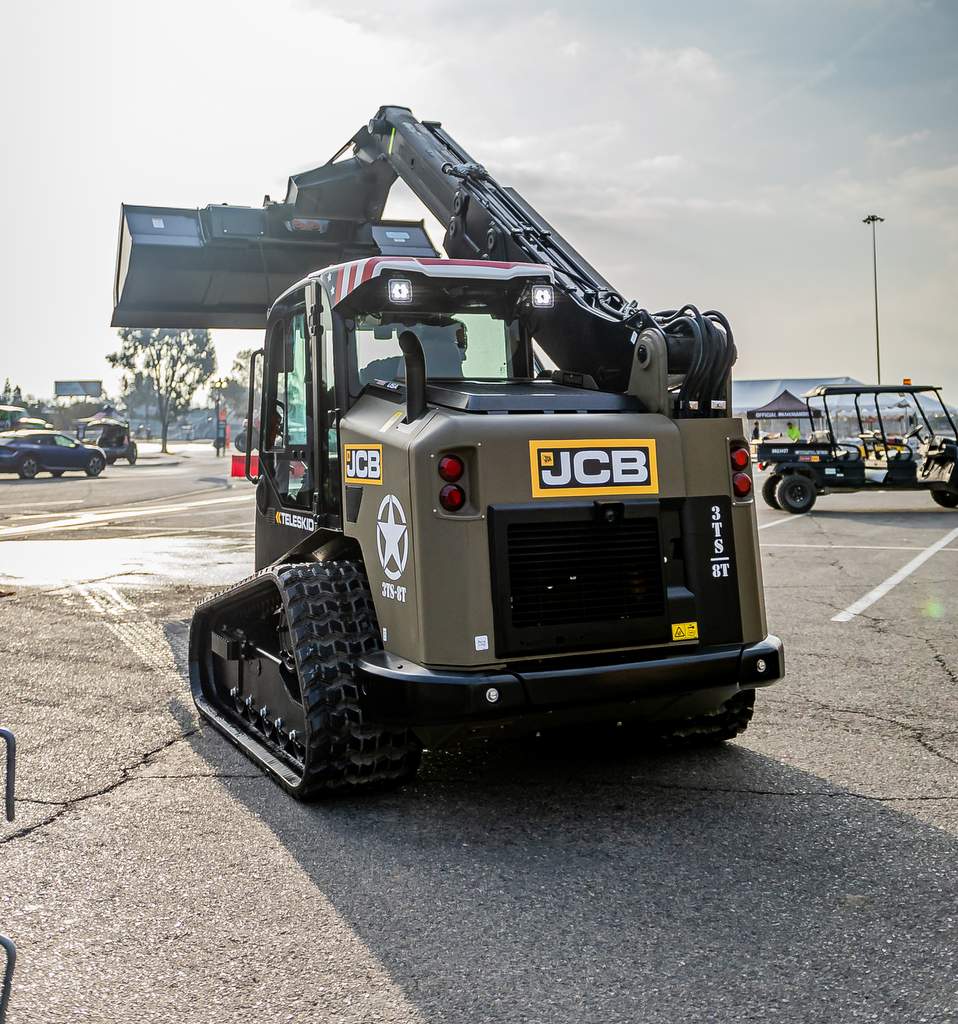
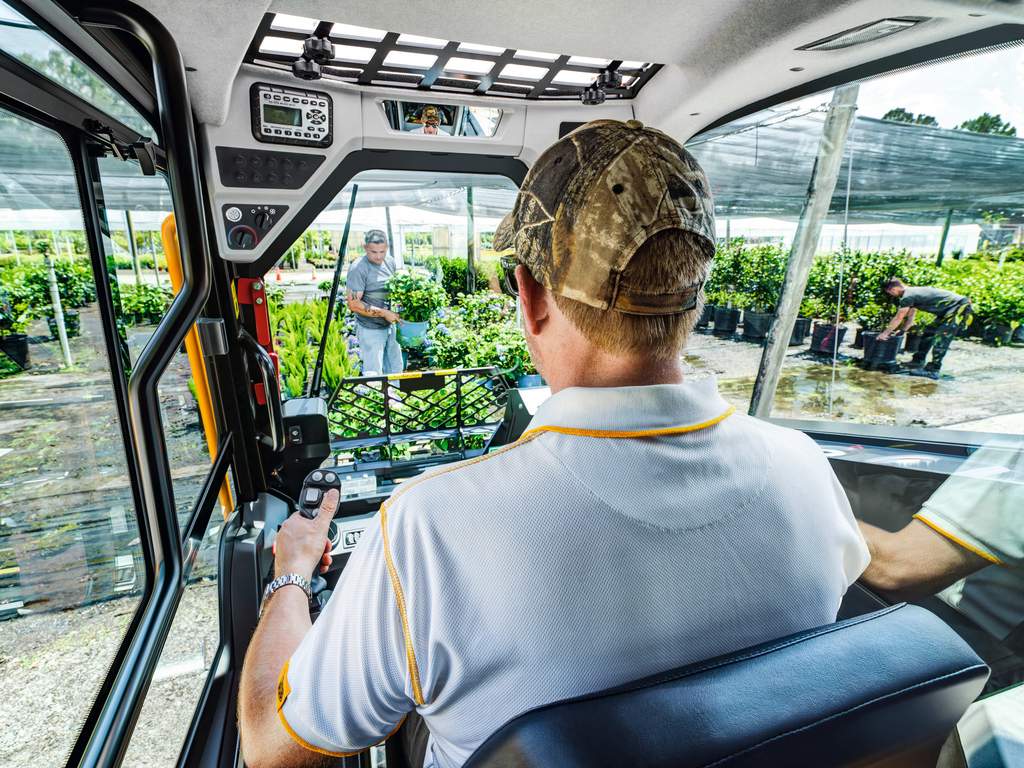

Comments are closed here.